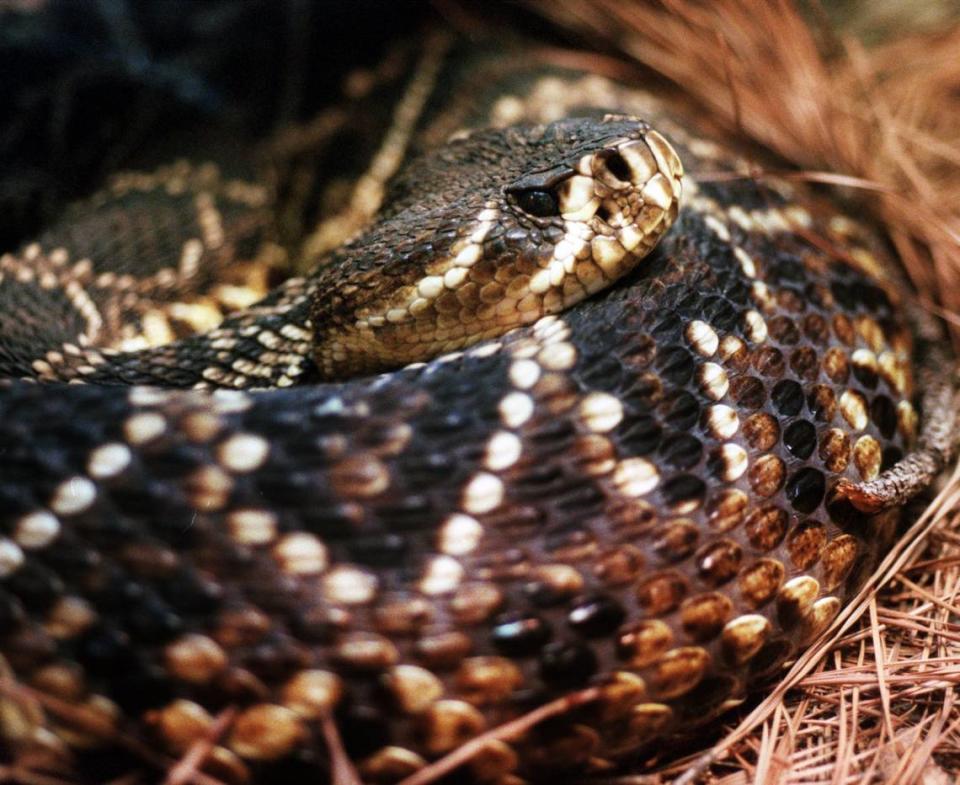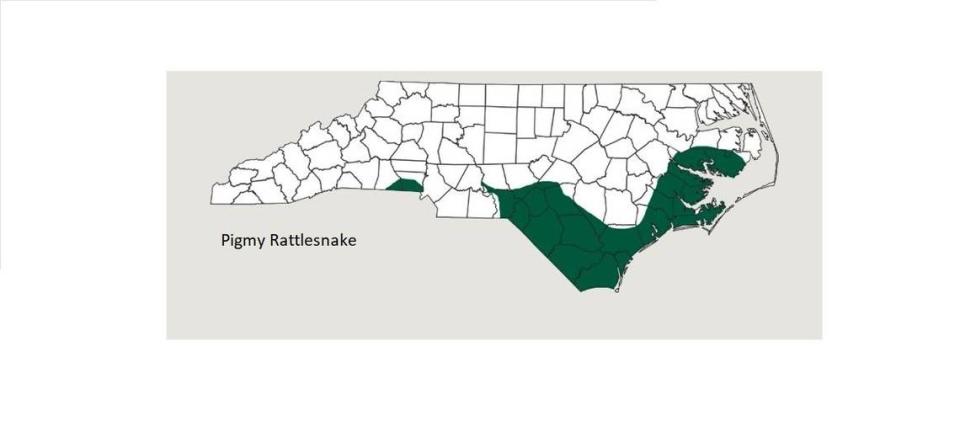There are 3 types of rattlesnakes found in NC. Here’s how to identify them.
Copperhead snakes, found virtually everywhere in the Triangle during warm weather months, get a lot more attention than rattlesnakes, even though rattlesnake bites can be much more dangerous.
Both snakes are venomous pit vipers found across North Carolina, but you likely won’t see a rattlesnake in the Triangle.
Rattlesnakes are found in surrounding areas, however, particularly east, west and south of the Triangle.
“I feel safe to say it’s virtually impossible to see a rattlesnake in the Triangle,” said Kevin Bischof, a park superintendent with the N.C. Division of Parks and Recreation. “And due to poaching, habitat loss and low reproductivity rates, none of them are common in their ranges.”
There’s no need to avoid certain areas of the state because of rattlesnakes, and there’s no cause for concern even during late summer’s baby rattlesnake season, he said.
But we should all learn how to identify the snakes and how to behave if we spot one while camping, hiking or enjoying the outdoors in North Carolina.
Here’s what to know about rattlesnakes in the state.
Of the 6 venomous snake species native to N.C., 3 are rattlesnakes – pigmy, timber & Eastern diamondback. Each one is protected by the North Carolina Endangered Species Act. Spot a rattler? Email rattlesnake@ncwildlife.org a pic, date, time and GPS location. s: Jeff Hall pic.twitter.com/BXahfADXWX
— N.C. Wildlife (@NCWildlife) May 1, 2021
Venomous snakes in North Carolina
The N&O has a comprehensive guide on venomous snakes in the state. For the full guide, visit newsobserver.com/news.
Here’s an excerpt:
“Snakes generally aren’t cause for much concern, but encounters can be a little scary for some (for the snakes as well as the people). It’s important to know that of the 38 species of snakes in North Carolina, the majority are nonvenomous and not aggressive toward people unless threatened. There are six types of venomous snakes found in North Carolina.
▪ What’s the head shape? A commonly shared rule of thumb is that most venomous snakes have a triangular or diamond-shaped head, while nonvenomous snakes have a tapered head. You can’t rely on that, though.
Some nonvenomous snakes (such as a rat snake) can mimic the triangular shape of venomous snakes by flattening their heads when threatened (to avoid becoming the prey of another animal), so never go by head shape alone.
▪ Can you see its eyes? Another tricky but often shared tip is to check out the pupil shape. Venomous snakes have been said to have oblong pupils that look like a slit in the center of the eye, whereas nonvenomous snakes will have a round pupil.
In fact, according to a document on the NC Wildlife website, a snake’s pupils can dilate just like a human’s, and can look round. The best way to know if a snake is venomous is to know which venomous snakes are common in your area and know what they look like.”
It’s not safe to get close enough to view pupils, but cell phone cameras can get a photo and you can zoom in on the eyes from a safe distance, N.C. Parks’ Bischof said.

Rattlesnake bites can be deadly
Venom from a rattlesnake bite is more serious than venom from a copperhead, but the bites are far less common.
“Within an hour outside of the Triangle, you can start seeing these other snakes. Rattlesnakes have more severe issues with mortality or loss of limb,” said Dr. Ben German, an emergency department physician at WakeMed who specializes in snake bites.
A North Carolinian died after being bitten by a rattlesnake near the coast this year, said Dr. Michael Beuhler, NC Poison Control’s medical director. He believes the bite was from an Eastern Diamondback, which tends to be the least common rattlesnake bite observed in the state.
“We’ve seen seven rattlesnake bites this year, and we actually did have a death from a rattlesnake, which is very uncommon,” he said.
Earlier this month, respected snake researcher William “Marty” Martin died after being bitten by a captive timber rattlesnake at his home in Harpers Ferry, West Virginia, reported the Washington Post.
Are you sure it’s a rattlesnake? Look at the tail.
First, identify that the snake you’re seeing is actually a rattlesnake.
“Without sounding sarcastic, I ask folks if the snake they saw had a rattle on its tail,” Bischof said. “The Pigmy Rattlesnake has a very small rattle, and some nonvenomous snakes will rattle their tails in dry leaves, which mimic rattlesnakes. But generally, I tell folks to look at the tail.”
As with any snake, if you aren’t sure what kind it is, keep your distance from it.
But N.C. State Parks folks are more concerned about visitors getting hurt from water, roads, cliffs/drop offs and waterfalls, than from snakes. There have been very few snake bites in N.C. State Parks, and Bischof said he isn’t aware of any venomous bite fatalities.
“Many of our park visitors across the state are afraid of snakes and will ask a lot of questions about them and the danger they pose,” he said.
“While I have concern about our visitors and their interaction with venomous snakes, it isn’t my top concern.”
An extremely rare snake in North Carolina, the Eastern Diamondback Rattlesnake is only found in a few locations. A handsome and charismatic animal, the diamondback uses its rattle as a defensive warning. The diamondback is a true icon of the Southeast! pic.twitter.com/DYO72zJsaY
— N.C. Wildlife (@NCWildlife) June 4, 2022
Three types of rattlesnakes in NC
There are three rattlesnake species in North Carolina: Timber “Canebrake” Rattlesnake, Eastern Diamondback Rattlesnake and the Carolina Pigmy Rattlesnake.
The NC Wildlife Resources Commission, a state government agency that conserves NC’s fish and wildlife, has a handy guide to identifying rattlesnakes, showing where to find certain species and providing information about their natural history.
Here’s what to know:

Timber “Canebrake” Rattlesnake in NC
The Timber Rattlesnake, often called the Canebrake Rattlesnake, is the most common rattlesnake in the state, Bischof said.
Closest to the Triangle, the Timber Rattlesnake can be found in Harnett County, bordering the southwestern portion of Johnston County. It may be found in a small section of northeastern Durham County, according to maps by the NC Wildlife Resources Commission.
“I always found the locality in northern Durham County an interesting observation,” Bischof said. “I don’t know the exact specifics on this small portion of range map, but I would be very surprised if someone saw one in this area.”
Location:
Most commonly found in the Mountains and Coastal Plain. They can be found in all western, eastern and southern counties of the state.
This snake is primarily in forested areas.
Identifying characteristics:
Large and heavy-bodied. Can be up to five-and-a-half feet long.
In the Mountains, these snakes are usually yellow, dark gray or black.
In the Piedmont and Coastal Plain, these snakes are usually light brown, gray, tan or with a pinkish background.
They have dark crossbands on a lighter background, and their tails — which have a rattle on the end — are usually black.
Natural history:
This rattlesnake is reluctant to rattle or bite.
They eat mice and squirrels, occasionally birds.
They typically hibernate communally.
In late summer, these snakes bear up to 20 young.
Venom is highly toxic. Deaths from bites are known but very rare.
Source: ncwildlife.org

Eastern Diamondback Rattlesnake in NC
The Eastern Diamondback Rattlesnake is the least common rattlesnake to be seen in the state, Bischof said.
This snake is most commonly found in southern counties of the state. Cumberland and Jones counties are the northernmost counties where this rattlesnake can be found, according to maps by the NC Wildlife Resources Commission.
Location:
Most commonly found in the southeastern Coastal Plain.
Primarily in long-lead pine flatwoods and sandhills.
Identifying characteristics:
Heavy bodied. Can be up to six feet in length.
Their heads are triangle-shaped, and there are dark bands across the face that cover their eyes.
There are two straight lines that run along the sides of the snake’s head.
There’s an average of 28 dark, diamond-shaped markings around the body. The diamonds have light-colored borders.
The end of the tail has a rattle.
Natural history:
These snakes are active from March to October.
In the fall, this snake bears seven to 21 young.
They eat mostly rodents and rabbits.
They overwinter in stump cavities and in mammal burrows.
Venom is highly toxic. Deaths from bites are known but very rare.
Source: ncwildlife.org

Carolina Pigmy Rattlesnake in NC
The Carolina Pigmy Rattlesnake can be found in the southern portion of the state, and its northern range isn’t much farther north of Beaufort County on the coast, Bischof said.
There was an isolated population west of Charlotte (in and around Crowders Mountain State Park), but Bischof thinks the last time one was seen there was in the 1980’s. It may be found in a southwestern portion of Harnett County, according to maps by the NC Wildlife Resources Commission.
Location:
They’re in the southeastern Coastal Plain, Sandhills and a few portions of the southern Piedmont.
Most commonly found in pine flatwoods and scrub oak habitats.
Identifying characteristics:
The Carolina Pigmy Rattlesnake is small — the average size is 15 to 20 inches.
They make a small rattling noise, which can sound like an insect buzz.
They’re a dull gray color with a row of dark spots down the center of their backs. There’s a smaller row of spots along the snakes’ sides.
The snakes in the Coastal Plain counties typically have a red or pink background color.
Natural history:
They’re active day and night, but they’re rarely seen due to camouflage.
They eat lizards, frogs, small snakes, large arthropods and small mammals.
They overwinter in logs, stumps and mammal burrows.
In late summer, they bear three to nine young.
Source: ncwildlife.org


 Yahoo Movies
Yahoo Movies 
